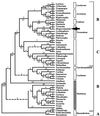Molecular evidence for an African origin of the Hawaiian endemic Hesperomannia (Asteraceae)
- PMID: 9860987
- PMCID: PMC28061
- DOI: 10.1073/pnas.95.26.15440
Molecular evidence for an African origin of the Hawaiian endemic Hesperomannia (Asteraceae)
Abstract
Identification of the progenitors of plants endemic to oceanic islands often is complicated by extreme morphological divergence between island and continental taxa. This is especially true for the Hawaiian Islands, which are 3,900 km from any continental source. We examine the origin of Hesperomannia, a genus of three species endemic to Hawaii that always have been placed in the tribe Mutisieae of the sunflower family. Phylogenetic analyses of representatives from all tribes in this family using the chloroplast gene ndhF (where ndhF is the ND5 protein of chloroplast NADH dehydrogenase) indicate that Hesperomannia belongs to the tribe Vernonieae. Phylogenetic comparisons within the Vernonieae using sequences of both ndhF and the internal transcribed spacer regions of nuclear ribosomal DNA reveal that Hesperomannia is sister to African species of Vernonia. Long-distance dispersal northeastward from Africa to southeast Asia and across the many Pacific Ocean island chains is the most likely explanation for this unusual biogeographic connection. The 17- to 26-million-year divergence time between African Vernonia and Hesperomannia estimated by the DNA sequences predates the age of the eight existing Hawaiian Islands. These estimates are consistent with an hypothesis that the progenitor of Hesperomannia arrived at one of the low islands of the Hawaiian-Emperor chain between the late Oligocene and mid-Miocene when these islands were above sea level. Subsequent to its arrival the southeast Pacific island chains served as steppingstones for dispersal to the existing Hawaiian Islands.
Figures



References
-
- Adsersen H. In: Islands: Biological Diversity and Ecosystem Function. Vitousek P, Loope L L, Adsersen H, editors. Berlin: Springer; 1995. pp. 7–21.
-
- Wagner W L, Herbst D R, Sohmer S H. Manual of the Flowering Plants of Hawaii. Honolulu: Univ. of Hawaii Press; 1990.
-
- Fosberg F R. In: Insects of Hawaii. Zimmerman E C, editor. Vol. 1. Honolulu: Hawaii Univ. Press; 1948. pp. 107–119.
-
- Wagner W L. In: The Unity of Evolutionary Biology: The Proceedings of the Fourth International Congress of Systematics and Evolutionary Biology. Dudley E C, editor. Vol. 1. Portland, OR: Dioscorides; 1991. pp. 267–284.
-
- Baldwin B G, Robichaux R H. In: Hawaiian Biogeography: Evolution on a Hot Spot Archipelago. Wagner W L, Funk V A, editors. Washington, DC: Smithsonian Institution Press; 1995. pp. 259–287.
Publication types
MeSH terms
Substances
Associated data
- Actions
- Actions
- Actions
- Actions
- Actions
- Actions
- Actions
- Actions
- Actions
- Actions
- Actions
- Actions
- Actions
- Actions
- Actions
- Actions
- Actions
- Actions
- Actions
- Actions
- Actions
- Actions
- Actions
- Actions
- Actions
- Actions
- Actions
- Actions
- Actions
- Actions
LinkOut - more resources
Full Text Sources

